
Home » Industry Skeptical of Reference Databases In FDA Draft Guidance for NGS-Based Diagnostics
Industry Skeptical of Reference Databases In FDA Draft Guidance for NGS-Based Diagnostics
Although industry overall commended the FDA for developing guidelines for next-generation sequencing technologies for infectious disease diagnostics, stakeholders questioned whether the agency’s reference-grade databases would be sufficient to detect the vast majority of pathogens in the near future.
Microbiologics said in its comments that the reference databases listed in the draft guidance, such as the FDA-ARGOS and the NIST microbial standard reference materials, are not at a capacity to meet current diagnostics needs.
After extending the comment period from Aug. 11 to Sept. 12, the FDA received 10 comments on the draft guidance. Released May 13, the draft guidance spells out how the agency plans to regulate diagnostics that detect infectious disease organisms, antimicrobial resistance and virulence markers.
The Critical Path Institute said the regulatory-grade reference database requirements for microbial identification and antimicrobial resistance are undefined and quite different, and it suggested the two concepts be separated out.
Oxford Nanopore said that an “overly prescriptive approach to individual performance metrics (which will vary widely between pathogens, sample types and sequencing technologies) may fail to capture the benefits of newer technologies.” It suggested instead focusing on the properties and performance of technologies overall in the intended-use cases.
Roche Diagnostics echoed that sentiment and was critical of the FDA’s approach to regulating NGS in vitro diagnostics for infectious disease via a systems approach. Such an approach would limit innovative tools, because manufacturers often specialize in areas such as target enrichment, instrumentation and bioinformatics pipelines.
“This approach is diametrically opposed to FDA’s expressed policies and precedent,” Roche said.
It urged the agency to adopt a more flexible regulatory pathway that enables developers of NGS assays or bioinformatics pipelines to develop and evaluate their products using existing and innovative NGS instrument platforms.
The Critical Path Institute said the draft guidance appears to be specific to whole genome sequencing, but it asserted that targeted sequencing “may make more sense for diagnostic applications.” It suggested that the agency develop a section devoted to targeted sequencing.
The institute also said the guidance does not contain a discussion on subpopulation analysis for antimicrobial resistance.
Exempt from Premarket Notification?
Roche said the agency should consider exempting Class II infectious disease NGS-based tests from premarket notification requirements under certain circumstances. It explained that the agency took this approach for NGS-based germline guidance, and it should follow the same pathway since the risks associated with such tests would be similar.
Oxford Nanopore said the guidelines appear focused on centralized clinical laboratory-delivered testing based on traditional, short-read technologies and don’t take into account newer, portable, real-time, long-read DNA sequencing technologies, including those based on nanopore sensing.
The company stressed that a “point-of-care device with a rapid workflow” has the potential to deliver rapid results, which would provide numerous benefits.
The guidance was drawn from stakeholder input during an April 13, 2015, meeting that stressed the need for more advanced testing to better detect and identify infectious disease organisms. Stakeholders stressed that next-generation sequencing can replace previous methods with a single approach.
With FDA inspections getting tougher every day you need to be well-versed in the regulations you must follow and the procedures the agency will use to conduct your inspection. Luckily for you there is a complete resource available to help you get that edge. Be prepared and up-to-date with your own copy of Medical Device Inspections Guide, 2016 Edition.
Upcoming Events
-
23Apr
-
25Apr
-
07May
-
14May
-
30May

